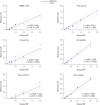Targeted Next-Generation Sequencing of Plasma Cell-Free DNA in Korean Patients with Hepatocellular Carcinoma
- PMID: 33063681
- PMCID: PMC7591296
- DOI: 10.3343/alm.2021.41.2.198
Targeted Next-Generation Sequencing of Plasma Cell-Free DNA in Korean Patients with Hepatocellular Carcinoma
Abstract
Background: Hepatocellular carcinoma (HCC) is the second-most-common cause of cancer-related deaths worldwide, and an accurate and non-invasive biomarker for the early detection and monitoring of HCC is required. We assessed pathogenic variants of HCC driver genes in cell-free DNA (cfDNA) from HCC patients who had not undergone systemic therapy.
Methods: Plasma cfDNA was collected from 20 HCC patients, and deep sequencing was performed using a customized cfDNA next-generation sequencing panel, targeting the major HCC driver genes (TP53, CTNNB1, TERT) that incorporates molecular barcoding.
Results: In 13/20 (65%) patients, we identified at least one pathogenic variant of two major HCC driver genes (TP53 and CTNNB1), including 16 variants of TP53 and nine variants of CTNNB1. The TP53 and CTNNB1 variants showed low allele frequencies, with median values of 0.17% (range: 0.06%-6.99%) and 0.07% (range: 0.05%-0.96%), respectively. However, the molecular coverage of variants was sufficient, with median values of 5,543 (range: 2,317-9,088) and 7,568 (range: 2,400-9,633) for TP53 and CTNNB1 variants, respectively.
Conclusions: Our targeted DNA sequencing successfully identified low-frequency pathogenic variants in the cfDNA from HCC patients by achieving high coverage of unique molecular families. Our results support the utility of cfDNA analysis to identify somatic gene variants in HCC patients.
Keywords: CTNNB1; Cell-free DNA; Hepatocellular carcinoma; Molecular barcoding; Next-generation sequencing; Pathogenic variants; TERT; TP53.
Conflict of interest statement
No potential conflicts of interest relevant to this article were reported.
Figures


References
MeSH terms
Substances
LinkOut - more resources
Full Text Sources
Other Literature Sources
Medical
Research Materials
Miscellaneous

